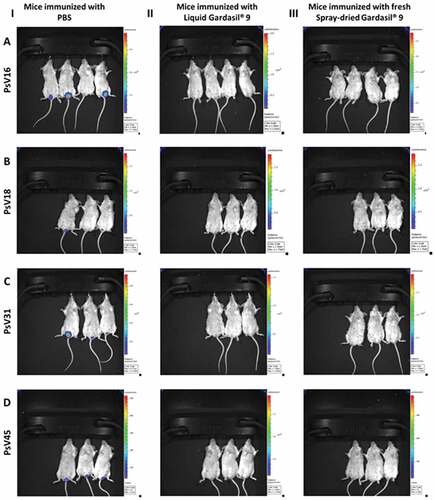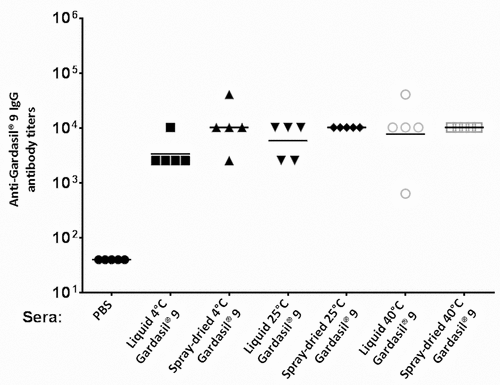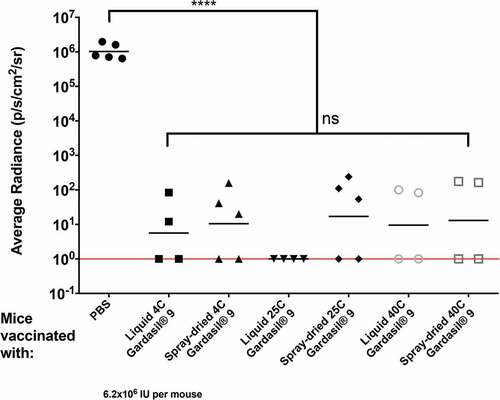Figures & data
Figure 1. Anti-Gardasil® 9 antibody titers in mice. Mice were immunized with liquid (non-spray-dried), freshly spray-dried Gardasil® 9, or with PBS (control) and boosted with the same dose three-weeks after the first immunization. Sera were collected three weeks after the boost immunization and anti-Gardasil® 9 IgG titers were determined by ELISA.

Figure 2. IVIS images: bioluminescence signal in the genitals of mice immunized with (I) phosphate buffered saline (PBS), (II) liquid Gardasil® 9 suspension, or (III) fresh spray-dried Gardasil® 9 powder and infected with HPV (A) PsV16, (B) PsV18, (C) PsV31, and (D) PsV45.

Figure 3. Protection against HPV PsVs 16, 18, 31, and 45. Groups of 3–6 BALB/c mice were immunized i.m. twice with 10 µg of either liquid or fresh spray-dried Gardasil® 9 (equivalent to 2.22 µg PsV16 VLPs, 1.48 µg PsV18 VLPs, 0.74 µg PsV31 VLPs, and 0.74 µg PsV45 VLPs). Three weeks after the boost immunization, mice were vaginally challenged sequentially with various HPV PsV types [PsV16 (8.76 × 10Citation6 IU), PsV18 (3 × 10Citation5 IU), PsV31 (2.5 × 10Citation7 IU), and PsV45 (9.3 × 10Citation6 IU)]. Two days later, 0.4 mg of luciferin was instilled vaginally and images were taken 3 minutes post-luciferin instillation. The average radiance (p/s/cm2/sr) of luciferase expression at the genitals was determined using Living Image 4.1 software. Background radiance (determined by gating on another region of the mouse) was subtracted from this value. Each datum represents the radiance value of an individual mouse and the lines represent the average geometric mean for each group. Statistical analysis was done using one-way ANOVA, Tukey’s multiple comparison test; ns – not significant, *p < 0.05 and **p < 0.01. Red line indicates limit of detection.
![Figure 3. Protection against HPV PsVs 16, 18, 31, and 45. Groups of 3–6 BALB/c mice were immunized i.m. twice with 10 µg of either liquid or fresh spray-dried Gardasil® 9 (equivalent to 2.22 µg PsV16 VLPs, 1.48 µg PsV18 VLPs, 0.74 µg PsV31 VLPs, and 0.74 µg PsV45 VLPs). Three weeks after the boost immunization, mice were vaginally challenged sequentially with various HPV PsV types [PsV16 (8.76 × 10Citation6 IU), PsV18 (3 × 10Citation5 IU), PsV31 (2.5 × 10Citation7 IU), and PsV45 (9.3 × 10Citation6 IU)]. Two days later, 0.4 mg of luciferin was instilled vaginally and images were taken 3 minutes post-luciferin instillation. The average radiance (p/s/cm2/sr) of luciferase expression at the genitals was determined using Living Image 4.1 software. Background radiance (determined by gating on another region of the mouse) was subtracted from this value. Each datum represents the radiance value of an individual mouse and the lines represent the average geometric mean for each group. Statistical analysis was done using one-way ANOVA, Tukey’s multiple comparison test; ns – not significant, *p < 0.05 and **p < 0.01. Red line indicates limit of detection.](/cms/asset/da303765-5dd2-4296-880b-72afdecb7bca/khvi_a_1593727_f0003_oc.jpg)
Figure 4. Anti-Gardasil® 9 antibody titers in mice after immunization with Gardasil® 9 stored for 3 months at different temperatures. Mice were immunized twice with either liquid or spray-dried Gardasil® 9 stored at 4°C, 25°C/60% RH, and 40°C/75% RH or with PBS (control) at three-week intervals. Sera were collected three weeks after the last immunization and anti-Gardasil® 9 IgG titers were determined by ELISA. Each datum represents the IgG antibody value of an individual mouse.

Figure 5. Mice immunized with spray-dried Gardasil® 9 dry powder stored for three months at 4°C, 25°C/60% RH, and 40°C/75% RH confers protection against HPV PsV16. Groups of 4–5 female BALB/c mice were immunized i.m. twice with 10 µg of either liquid or fresh spray-dried Gardasil® 9 (equivalent to 2.22 µg PsV16 VLPs). Three weeks after the boost immunization, mice were vaginally challenged with HPV PsV16 6.2 × 10Citation6 IU. Two days later, 0.4 mg of luciferin was instilled vaginally and images were taken 3 minutes post-luciferin instillation. The average radiance (p/s/cm2/sr) of luciferase expression at the genitals was determined using Living Image 4.1 software. Background radiance (determined by gating on another region of the mouse) was subtracted from this value. Each datum represents the radiance value of an individual mouse and the lines stand for the average geometric mean for each group. Statistical analysis was done using one-way ANOVA, Tukey’s multiple comparison tests; ns – not significant, ****p < 0.0001. Red line indicates limit of detection.

